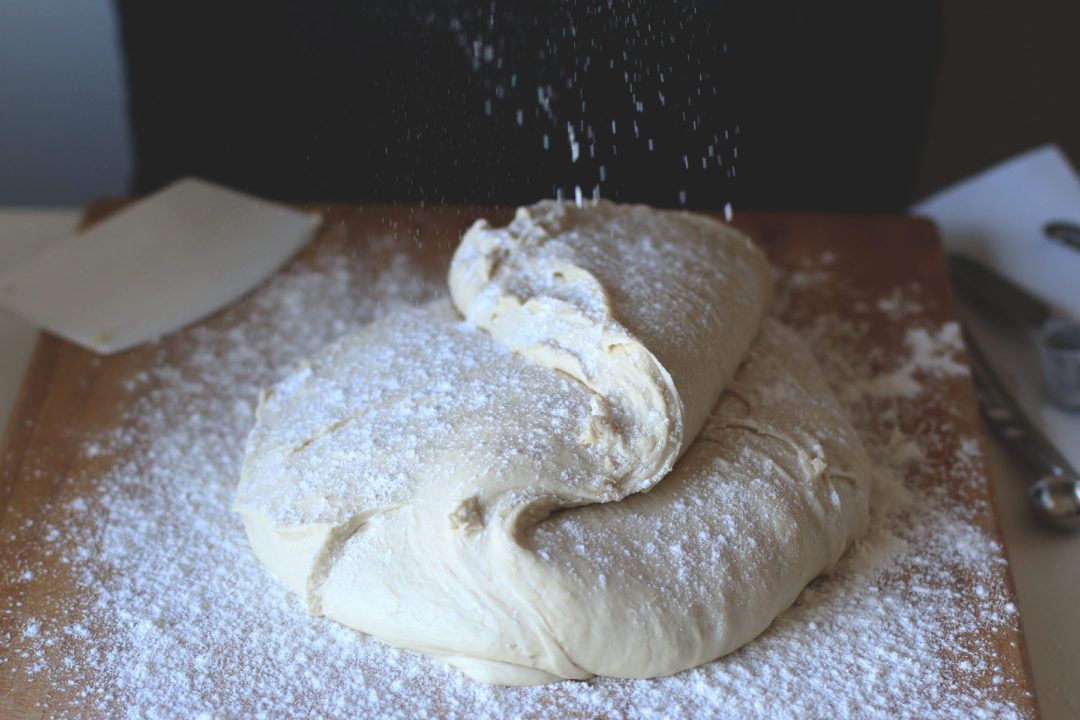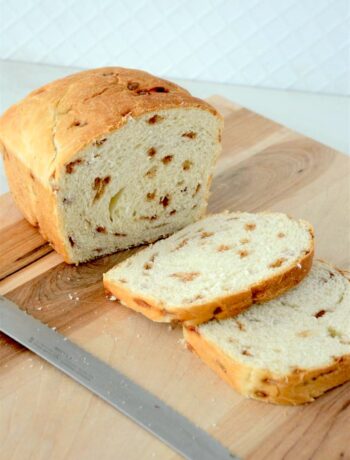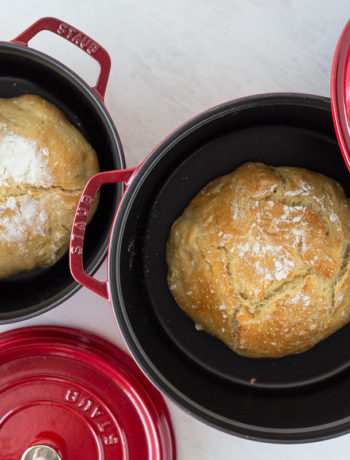I have had an interesting relationship with yeast. For the most part, we are pretty good friends. I understand it, it understands me. But there a few times where I have gotten a little over-confident and it quickly puts me right back in my place. This recipe is not one of those times. We discovered this recipe over 10 years ago, and its one of my favorite things to share with people (especially when they are buying their first Le Creuset pot for the first time!). Its contains the most simple of ingredients, it doesn’t require a lot of effort, and its truly amazing to watch how ingredients, if given the right time, will naturally do some beautiful and amazing things. This recipe requires time, time, and a little more time. But the flavors that are created are worth all the time in the world.
Plan ahead, watch the yeast, salt and flour do their wonders (look for those beautiful air pockets in your dough and strands of gluten when you release the dough from your bowl– its amazing!). And most of all– don’t be afraid to try! This recipe is easy and fun to change flavors by adding fresh herbs- but try it this way first– you won’t be sad you did!
Ingredients
- 3 cups (400 grams) all-purpose flour
- 1 1/4 teaspoons (8 grams) table salt
- 1/4 teaspoon (1 gram) instant or other active dry yeast
- 1 1/3 cups (300 grams) cool water (55 to 65 degrees F)
- cornmeal, or additional flour, for dusting
- 4 1/2- to 5 1/2-quart heavy pot
Directions
- In a medium bowl, stir together the flour, salt, and yeast. Add the water and, using a wooden spoon, mix until you have a wet, sticky dough, usually takes about 30 seconds. Make sure it's really sticky to the touch; if it's not, mix in another tablespoon or two of water. I usually have to add just a bit more water.
- Cover the bowl with a tea towel, or plastic wrap and let sit at room temperature (about 72 degrees F), out of direct sunlight, until the surface is dotted with bubbles and the dough is more than doubled in size. This will take a minimum of 12 hours and up to 18 hours. This slow rise?fermentation?is the key to flavor. So the longer the better.
- After the 12-18 hours is complete, dust counter with flour. Use a bowl scraper or rubber spatula to scrape the dough onto the board in one piece. When you begin to pull the dough away from the bowl, it will cling in long, thin strands (this is the developed gluten), and it will be quite loose and sticky?do not add more flour. Use lightly floured hands or a bowl scraper or spatula to lift the edges of the dough in toward the center. Nudge and tuck in the edges of the dough to make it round.
- Place a sheet or parchment or a heavily floured flour sack towel (not terry cloth, which tends to stick and may leave lint in the dough), on your work surface and generously dust the cloth with cornmeal, or flour. Use your hands or a bowl scraper to gently lift the dough onto the towel, so it is seam side down. If the dough is tacky, dust the top lightly with cornmeal, or flour. Fold the ends of the towel loosely over the dough to cover it and place it in a warm, draft-free spot to rise for 1 to 2 hours. The dough is ready when it is almost doubled. If you gently poke it with your finger, making an indentation about 1/4 inch deep, it should hold the impression. If it doesn't, let it rise for another 15 minutes.
- Half an hour before the end of the second rise, preheat the oven to 475 degrees F, with a rack in the lower third position, and place a covered 4 1/2?5 1/2 quart heavy pot in the center of the rack.
- Using pot holders, carefully remove the preheated pot from the oven and uncover it. Unfold the tea towel, lightly dust the dough with flour, lift up the dough, either on the towel or in your hand, and quickly but gently invert it into the pot, seam side up. (Use caution?the pot will be very hot.) If you used parchment paper you can carefully lift the corners of the parchment and set directly into pot. Carefully so you do not touch the pan. If parchment is pressed into dough too much it will bake that way leaving the indentation, so carefully try to pull away from sides. Cover the pot and bake for 30 minutes.
- Remove the lid and if baked on parchment, take pan out and carefully remove parchment. Your bread will slide right off, but this will allow it all to brown nicely. Place back in oven and bake until the bread is a deep chestnut color but not burnt, use a heatproof spatula or pot holders to carefully lift the bread out of the pot and place it on a rack to cool thoroughly. Don't slice or tear into it until it has cooled, which usually takes at least an hour. Good luck, that's the hardest part-- waiting for the bread to be ready.
This bread bakes inside a Le Creuset pot that makes its own oven inside the pot. You will notice that the dough while rising becomes very wet and sticky. The moisture in the dough will bake inside the pot creating the perfect steam to give you an amazing crust and soft delicious bread inside. This is by far the best way to bake this bread. If you do not have an enamel coated dutch oven, come see us- or you can use a baking stone with a pan of water underneath. It does work well, but its best when baked in a dutch oven. Just remember, the pans are hot- be careful lifting and placing your bread in!
And PLEASE share with us your bread making adventures! We would love to hear your favorite ways to bake- and if you do this recipe please let us know! On instagram use the hashtag #gygieats, and @orsongygi and will stay caught up with you!




